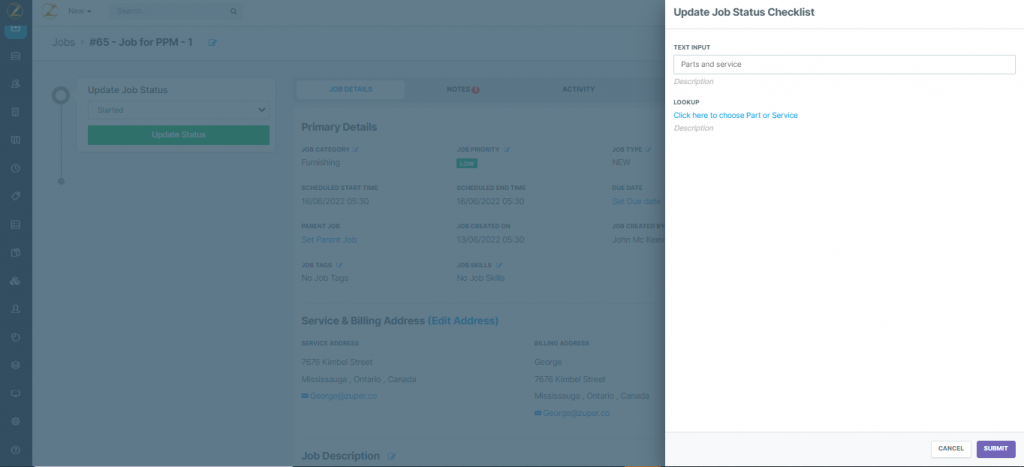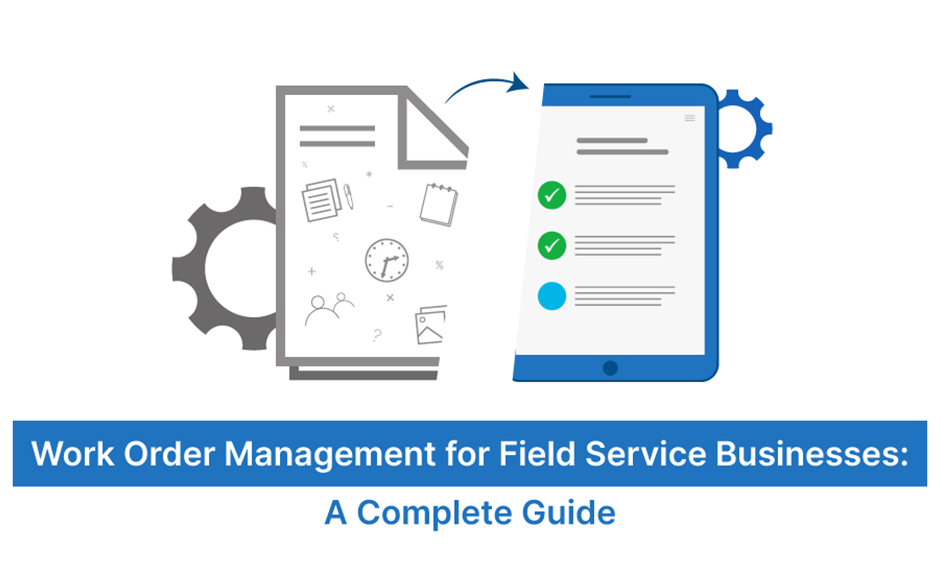It is a typical Monday morning, and you are in the middle of distributing work orders to your field workforce. As you are handing out stack after stack of assignments, you are mindful of the effects manual work orders have on operational efficiency.
For example, each day, your field service professionals have to drive to the office and pick up their work orders. This takes up not only time but using printed work orders also takes up space. By necessity, paper-based work orders need to be short and important information like asset or repair history is frequently left out.
In many cases, even a customer profile doesn’t make the cut; there just is not enough space! As a result, your field service technicians are in the position of playing phone tag with their back-office counterparts if there is any additional information that they need.
As you ponder over a way to solve the problems associated with manual work orders, a thought suddenly occurs to you!
As a small business owner, you decide to take on this task and assemble a team to execute it. The next day, you scan all the work orders, convert them into online forms, and share links with your field workforce. Now driving to the office is not necessary! All they have to do is follow the links! Neat!
And your team is excited to be rid of those awful paper forms. Everyone loves your idea, and they embrace these online forms wholeheartedly. End of story; the work order management process became seamless, and the service business flourished. Right?
Well, not really.
When small business owners hear the term “work order management,” they’ll most likely imagine something similar and simple with free online tools like spreadsheets and online forms. But your online forms and spreadsheets only scratch the surface of the many benefits that work order management software has to offer.
Work order management and work order management software are gaining traction post-pandemic.
But, if you truly believe work order management can be handled with online forms and spreadsheets—you’re in for a surprise.
Not only will this post cover the drawbacks of manual work orders, but it will also focus on the challenges faced by field service businesses who use online forms to manage their work orders. We intend to drive home the point of how effectively and efficiently your work order management process can be managed with field service management software.
Field service management apps like Zuper can give your entire team the clarity they need to create, manage, and process work orders. Unlike your cluttered spreadsheets, which provide the bare minimum information, work order management software can empower your field workforce with appropriate data.
In this blog, we will walk you through everything you need to know about word order management software, including what it is, how it can streamline your work order management process, and how to go about selecting the right tool for your service business.
What is work order management?
Work order management is an internal process used by organizations to get their work orders from creation to closure. A work order lifecycle consists of six steps: service request approval, work order creation, service scheduling, service request closure, documentation, and analysis. An ideal work order management process not only closes a work order but also helps deliver a good experience to customers.
While the steps involved in a work order process may vary from one organization to another, this image outlines the most common steps in a work order management process.
7 major drawbacks of manual work order management
Although paper-based work order management or online forms may seem like a straightforward approach, they have their own set of drawbacks. Additionally, they are difficult and time-consuming to manage.
Not to mention archaic work order management tools are incredibly outdated! Here are some of the shortcomings of manual work order management:
1. Too much manual effort
Even if you have a work order template You have to fill out each work order manually. That is the only way online work order management forms work. Your back-office team will spend significant time performing double entry; taking customer and job information from one work order system and entering it into another.
And, that is every time you get a service or maintenance request!
EVERY. SINGLE. TIME!
Then comes the sharing, printing, and shipping of work orders… Hopefully, your back-office team and field service technicians love playing phone tag because that is what siloed work orders ultimately cause.
What is more, archaic work order management is bound to demand human intervention, its associated errors are just an added bonus.
Just give it a thought.
Your field service team will have to rely on their back-office counterparts to retrieve additional details like service history that are not included in the original work order.
If the service request is not completed in one visit and multiple technicians are assigned to the problem, then your back-office team will spend considerable time briefing each one of them and bringing them up to speed.
In the worst-case scenario, your technicians appear unprepared and your customers become irate with your disorganized work order process.
Have you started panicking yet?
Well, you should be because this could lead to customer dissatisfaction and ultimately, churn. Also, your company’s reputation will be in tatters.
Do you still want to use manual processes to manage your work orders?
2. Doesn’t play well with other software
Online documents and spreadsheets are not the friendliest tools out there.
Once you make a list of all the solutions you could use, you may find that documents and spreadsheets do not rank nearly as high as you expected.
Do not expect your back-office team to be excited about the prospect of using multiple systems and performing double entries on a daily basis. In fact, you can expect them to hate it.
How does your team like manual work order management now?
3. Little to no visibility
Sure, you can share manual work orders with your team and even comment or tag your field service technician on that. But how do you know whether or not your field service technician has started working on it yet?
Furthermore, neither internal stakeholders (back-office team and supervisors) nor customers get work order updates. There is no way to filter work orders by assignees or even find out the status of a work order.
Of course, you can always call your technicians in the field for an update on the work order status. You can manually track the status of every work order when your team is small, but as you grow this manual practice will become burdensome.
How can you dispatch technicians or assign them work orders when you don’t have a way to see what your technicians are working on currently?
Just the thought of manually searching every work order template and seeing who’s assigned to what can induce nightmares. In a nutshell, this approach is highly unrealistic and time-intensive for large maintenance teams.
4. No effective way to collaborate
Modern work order management software revolves around real-time collaboration between the field team and back-office team including supervisors.
Did you know? Nearly 50% of employees in the US feel that their jobs are reliant on effective collaboration.
But online forms aren’t designed for this. Spreadsheets don’t focus on easy collaboration or communication. If a supervisor wants to leave a comment for his team, they will have to perform multiple searches just to pinpoint the right work order.
The only way out of this is to link your online forms to a collaboration platform or a project management tool. Even then, the collaboration process will not be seamless—which is hardly ideal.
5. Task management is a huge ordeal
Sometimes a work order tracking may need more work to complete than what was initially planned. This happens a lot in a service business scenario.
Yes, anyone can create and edit checklists easily in online documents, but making sure every step of the checklist is followed and enforcing accountability is virtually impossible—regardless of if, you are using paper forms or online files.
Also, the lack of permission restrictions with online forms can expose your organization to significant risks ranging from compliance to cyber security issues.
And we have not even talked about other aspects of task management, such as subtasks or delegation—for that, you would need to jump through hoops that would be sketchy at best.
6. Non-existent workflows
I mean, do spreadsheets even have workflows?
Short answer: No.
Long answer: It offers you a ton of rows and columns and the ability to add specific comments or tag a person.
You will have to dedicate days or even months to create elaborate workflow-like spreadsheets that are filled with every possible workflow information like start and finish date/time, task assignee columns, due dates, and more.
Don’t take our word for it!
A recent McKinsey study found that people spend nearly 9.3 hours every week looking up information. They spend this time digging for information in excel files, chasing after others for updates, and trying to cross-check data available across multiple interfaces,
And don’t even ask about how mindnumbing creating and managing that spreadsheet is!
Honestly, workflow management in spreadsheets is a recipe for clutter, confusion, and complexity!
7. Lack of reporting functionalities
Online forms and spreadsheets are tools with features like pivot tables, rich text formatting, and image attachments.
No features for reporting or summarizing though.
It can neither manage work orders automatically nor can it generate insights using the work order entries created by your team.
Yes, you have access to charts and can apply formulas, but your team has to manually feed and process the data, or there will be no charts to look at. This is not ideal.
A work order has volumes of data displayed in a single worksheet or document, what use is it if you have difficulty seeing patterns or are unable to draw any valuable insights out of it.
The crux of the problem is this: You need reports! And your online forms won’t generate any.
So, what now?
What is work order management software?
“The work order management software market was valued at $358.2 million in 2017, but it is expected to reach $694.6 million by the end of 2023.”
Work order management software is not just restricted to back-office agents. It can cater to everyone from field service professionals to supervisors and even your customers. Although it sounds impossible, all this and much more can be achieved with the right work order management software like Zuper.
Zuper Work Order Management Software should be the go-to product for field service businesses who are looking to improve their process, collaboration, accessibility, turnaround time, status updates, and more.
The collaborative nature of Zuper is a huge advantage for field service teams. Your internal teams perform the bulk of their work asynchronously. However, Zuper helps ensure that both internal and external stakeholders stay up-to-date with the latest and most accurate information at all times on work order management dashboard. Just imagine, with Zuper, your work orders are living, breathing documents around which work happens
With Zuper, everything from detailed asset history and customer information to invoices and work order notes are tied with Zuper’s Work Order Module because it is the heart of the product. Neither your field team nor your back-office agents will ever need to search for a stray invoice or asset detail because everything is connected to the work order.
Zuper’s Work Order Management System is built from the ground up to be used by a team. There is a built-in chat feature right there in the work order. Your stakeholders can have contextual conversations within the work order and even leave elaborate notes using our rich-text editor and image attachment functionality.
Key features to look for in work order management software
Online documents, while a useful tool, are not the solution to all inefficiencies at work. On the other hand, tools like Zuper’s Work Order Management Software provide an easy way to not only manage your work orders efficiently but also encourage communication amongst stakeholders and hold people accountable.
An ideal work order management system offers pre-made work order templates, integrates with other modules, provides cloud storage, enforces accountability, and more.
…but what goes into the making of the best work order management software?
Let’s take a closer look at the must-have features of a work order management solution:
1. Configurable statuses
Do your team members want to cut down back and forth phone calls?
Honestly, who doesn’t?
With configurable statuses, you can effortlessly reduce the number of status update calls between internal stakeholders. With these configurable statuses, you can map your end-to-end business processes without any compromises.
How?
Zuper lets you set statuses for each work order and keep everyone informed of what stage it is in. And the best part? You are not limited to pre-built status updates like “Open” or “Closed”. Your administrators can get as creative as they want.
Only Zuper workspace administrators can set up a status like “On My Way” to help technicians notify other stakeholders (including customers) when they are on their way to a job. Since field service businesses cater to multiple field service industries and each industry has its own set of processes, you can now set custom statuses for every industry.
2. Customizable checklists
Zuper’s task management functionalities are all about immediate action and keeping everyone in the loop.
Your administrators can find this in every task they create.
- Need to send notifications after a task is complete? Done!
- Need to add parts and services within checklists? Done!
- Need to enforce accountability in maintenance tasks? Done!
Need a stronger coffee? We don’t do that yet–but we are surely working on it! JK.
Checklists are the most important part of Zuper.
That’s why your administrators can create powerful checklists that are pretty detailed with layers of information.
Zuper checklists add an additional layer of protection to your work order process, allowing you to define detailed goals and maintenance tasks inside them. You can even set up your checklists to require an image attachment for an item to be marked complete. One of our customers uses our checklist feature to include customer signatures after work has been completed.
Our checklists support drag and drop functionality, you can easily organize your checklists by moving them up or down the list. You can even keep track of inventory by prompting your field technicians to add parts or list services used for fulfilling the work order.
But our best feature is the checklist template, you don’t have to create a checklist from scratch every time. Our checklist templates can instantly add the pre-built checklist into your work order in just a click.

What’s more, you can create dependent checklists in Zuper. Dependent checklists allow you to set up a workflow loop. You can initiate a unique workflow action based on your technician’s answer to a “Yes” or “No” question in the checklist.
3. Powerful workflows
With a work order management solution by your side, you don’t have to worry about broken workflows or missed deadlines.

Here’s how exactly an ideal field service management system can improve your workflow management process:
1. Automated workflows: not just here and there, we offer end-to-end automation.
2. Deadline tracking: you can set deadlines for every task in the workflow and track them easily
3. Employee efficiency: you can easily track your team’s productivity and efficiency
4. Accountability: you can assign service or maintenance tasks to stakeholders and hold them accountable
Luckily, there’s one maintenance management software that not only checks all these boxes but also provides much more when it comes to workflow management in field service—Zuper!
4. Impressive location services
Here are some common questions back-office agents answer every day:
Where is my field service technician? When will they reach my location?
Using Zuper allows your back-office agents to access the real-time location of the technician with ease. Fielding location-related questions is a piece of cake.
Zuper’s geo-tagging feature captures the accurate customer location on the work order. So, when your field service technicians change the status to “On My Way”, a contextual action window opens up. Our route optimization feature will prompt your technicians to either open Google Maps and travel or even book an Uber or Lyft to commute.
Woah! How easy is that?
5. Seamless collaboration within the work order
When you use online documents and separate tools for communication, most of your conversations about the work order happen in third-party messaging tools like WhatsApp or Slack. There is no way to attach this thread of conversation to your work order.

Zuper doesn’t merely let you comment on a work order. It lets you have all the conversations you need, right there! Inside a work order.
And there’s more…
You can have an entire conversation inside your work order, just like you would do on WhatsApp or Slack. At the end of the day, the conversation stays within the work order so that any other stakeholder can take one look at the conversation and understand the context.
Zuper’s work order notes feature is exemplary. Its rich-text editor helps collaborators to leave properly formatted internal notes on the work order. And don’t worry, these technical details or troubleshooting steps are not visible to your customers. Internal stakeholders can even leave private notes on a work order which is just visible to their eyes.
Your team can even attach images or files to the job notes section and it will be visible to other stakeholders if their comment is public.
This feature comes in handy during repeat visits especially when a new technician is assigned to a work order. The new technician doesn’t have to field calls from the back-office team to get up-to-speed about a work order history. All they need to do is take a closer look at the work order notes and the chat.
Easy, isn’t it?
6. Real-time notifications and alerts
You want to keep your customers and internal stakeholders in the loop, right?
You don’t have to schedule every individual message manually in your business communication solution.
What you need is a two-way synchronization of your work order system with your favorite messaging app.
Luckily, Zuper connects seamlessly with 10+ cloud telephony and SMS platforms like Twilio, RingCentral, ClickSend, GupShup, and more!
When there is a change in the work order status, you can trigger an automated notification to be delivered to your customers! When your field service technicians set their status as “On My Way”, your customers will receive an SMS with the ETA.
And there’s more…
Sure, you could send status alerts easily but what about job reminders and delay alerts. You don’t have to tear your hair out figuring out a way to send those.
In addition to sending timely job status alerts, you can also configure job reminders for field service technicians and even send your customers delay alerts when your technicians are running late for a job.
With Zuper’s intuitive notifications and alerts, you never have to worry about leaving your customers out of the communication loop!

7. Effortless recurring job management
If you’ve ever tried to manage recurring work orders and jobs with online or paper forms, then you have an idea how messy it can get.
Your spreadsheets will quickly become cluttered. And, it makes the process of keeping track of work order details incredibly difficult.
Zuper solves this problem by simplifying recurring job management. Instead of manually managing all your recurring jobs and work orders as separate entities, Zuper connects them all and provides a single source of truth.
Every work order in a recurring job displays the recurring job schedule. You can easily create and manage recurring jobs or even make a bulk update to existing recurring jobs, and more.

8. Deleted work orders recovery
To err is human.
There are instances where your field service team lost paper-based work orders by simply misplacing them. In those instances, you had to print a brand new work order and your field service technicians had to come all the way back to the office to retrieve them.
However, when you delete online forms and spreadsheets, you may have found a safety net with the trash bin. But the trash bin only stores deleted items for up to 30 days, you could never recover a document that was deleted a month ago.
Result? Your work orders are gone and they are not coming back.
However, Zuper Field Service Management Software solved this problem with a work order recovery feature. Using this functionality, you can recover work orders that were deleted within the past 90 days. If you want to recover a work order that was deleted before that time, you can get in touch with our customer success specialists and they will be glad to help you.

9. Robust reporting functionalities
Zuper offers a ton of powerful reporting functionalities to keep your team up-to-date with the progress of work orders.
And when we say tons, we are not exaggerating.
Zuper has more charts than the number of sequels in the Marvel movies franchise!
Our out-of-the-box reports like the work order time log report let you easily stay on top of your work orders. One look at it and you can answer questions like:
How long does it take a field service technician to close a work order?
What is the efficiency of a specific field service technician?
How many work orders can a technician work on every day?
And that’s not all.

Zuper’s work order reports offer insights on several KPIs in real-time. Here’s a glimpse of what you can do with Zuper’s reporting module:
Zuper has 15+ reports just on work orders.
Want a report on just the status of your work orders? Done.
Need a report on all the activities that happened in a work order? Yep, Zuper has that!
Looking for a report on how many work orders a specific field service technician has completed. Here you go.
Zuper’s powerful dashboard can give you visual overviews of your work order data. Best of all, you can customize your dashboard with the reports you need!
10. Hassle-free integrations
Not long ago, we had only a handful of tools to choose from. But now, there are many options to keep your field service workflow moving.
Luckily, unlike online documents, Zuper plays well with other third-party tools.
Whether you want to turn successfully closed deals in your CRM into work orders or need to connect your telephony apps with your work order system, Zuper is the right choice.
In fact, Zuper can be connected to 100+ apps, for free!

Zuper’s marketplace is filled with 100+ ready-to-use integrations. These apps range from CRMs and accounting software to collaboration tools and survey software.
Looking for an integration that is not available in Zuper Marketplace? Don’t worry, our Zuperheroes will build a custom integration just for you!
Do you know how hard it is to switch between apps to find the information you need? Especially when you are on the field? It is exhausting!
A work order management mobile app is essential to employee productivity, especially when you are working with a distributed workforce.
The Zuper Mobile App allows your technicians to do an array of things—access work orders, clock-in and clock-out, find the best route to their next service location, create estimates, convert estimates to invoices, and even collect payments online.
To be honest, once your field service technicians start using the Zuper Pro Mobile App, it will be hard to imagine how they ever got anything done without it!
Fun fact about our mobile app: work order statuses can be color-coded. Fun, isn’t it?
Conclusion
Yes, you can probably manage your work orders with spreadsheets and online documents or paper forms. But they are not just time-consuming, they are risky as well.
There’s no way to track technicians, ensure data accuracy, and errors are just inevitable. All of this will result in a bad experience for both internal and external stakeholders. Unsatisfactory field service experience is not something you want to deliver to your customers.
You would be better off with the right work order management software.
Like Zuper!
Why?
Because it’s an all-in-one solution.
Zuper can create and manage work orders, estimates, invoices, route maps, and more while managing your field service workforce and generating reports on every aspect of your field service management process.
Ready to automate your work order management? Then signup today for Zuper and say goodbye to filling your work orders manually, one document at a time.





